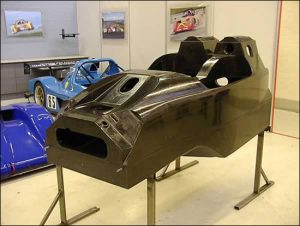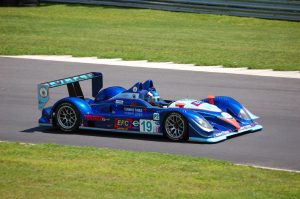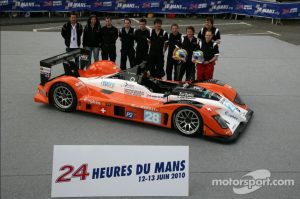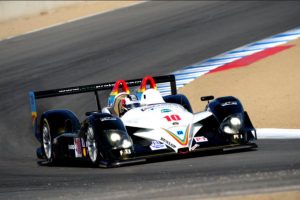In early 2005 Radical Sportscars had built nearly 450 race cars and was producing four different models, including the newly released SR8 which was joining the Clubsport/Prosport, SR3, and SR4. At that time the SR4 had been voted “Track Day car of the year” by Evo Magazine, and the new high downforce SR8 Sports racer was described by Autocar Magazine as “The greatest track car in Creation”. Then on March 15th, 2005, Radical announced its intentions to produce a car to race in the American and European Le Mans P2 series and the 24 hours of Le Mans. Well known Le Mans car designer Peter Elleray was hired to design the car for Radical and to leveraged much of what he had learned designing the Le Mans-winning Bentley prototypes. Radical’s initial concept was to make a “competitive and cost effective” Le Mans P2 Prototype that used an aluminum-carbon composite hybrid monocoque chassis and a 3.0L 525 hp version of the Radical / Powertec V8 engine. However, as the design progressed Radical decided, with encouragement from Peter Elleray, to change the focus of the program to a class winning car with a full carbon monocoque chassis and a drivetrain with proven Le Mans reliability. Radical teamed up with Advanced Engine Research (AER) and Judd Engine Developments LTD to produce the engines, and Ricardo to supply their reliable six speed sequential gearboxes that were used by Audi and other LMP teams. The SR9 was initially designed to run the AER 2-liter (1995cc) turbo-charged four-cylinder engine that produced 530 bhp and 457.3 ft lbs. Torque. But the lead customer for the SR9 was Rollcentre Racing who had an agreement with Judd Engine Development, so Radical redesigned the rear of the car to offer customers a naturally aspirated engine option in the Judd 3.4L (3397cc) flat plane V8 producing 530 bhp and 350 ft lbs. of torque.
In the original announcement the cost target for the SR9 was set at £120,000 to £130,000 with the engine and ancillaries costing another £30,000. The actual cost of the SR9 ended up being closer £190,000 for a rolling chassis and transmission, which was about half of the cost of the other LMP2 options. The Powertec AER engine cost £64,000 with £13,500 rebuild cost every 3,000 to 5,000 km.
A total of six SR9’s were built. About two months after the topic of building “Competitive and cost effective” Le Mans P2 Prototype first came up Radical announced their plans to design and build the SR9. Just 12 months after the announcement, SR9 chassis number 1 pulled out on the track for its first test, and two months after that the car competed at 24 hours of Le Mans for the first time. SR9’s competed in the Le Mans 24 hour race five times with the best finishes being 5th in class in 2006 and 6th in class in 2010
Previous
Next
Previous
Next
| Chassis Number | Picture / Info Link | Notes |
|---|---|---|
| SR9 001 |  Pictures / Info Link Pictures / Info Link | Radical SR9 Chassis number 1 was raced by Rollcentre Racing who was the lead customer for the SR9. They originally planned to purchase the first two chassis. The first chassis was to be raced by the Rollcentre factory team and the second chassis was to be raced by a “customer lease driver” that was supported by the Rollcentre Racing team. Chassis number 1 used a Judd 3.4L naturally aspirated V8 engine that produced 530 bhp and 350 ft. lbs. of torque. Rollcentre raced chassis number 1 in the 2006 Le Mans series. The car was completed literally hours before it was loaded on the truck for the first official Le Mans test at Paul Ricard on March 27th, 2006. The first race was in Istanbul on April 9 and two months later Chassis number 1 was the first SR9 to compete at Le Mans on June 18th, 2006, where it finished 5th in the LMP2 class and 20th overall. Chassis number 1 was used for FIA testing and was damaged in the testing process but was repaired to be used for the 2006 racing series. The car was retired after the 2006 racing season and in 2023 the tub of chassis number 1 was located at Greaves Racing in the U.K.. |
| SR9 002 |  Pictures / Info Link Pictures / Info Link | Radical SR9 chassis number 2 was originally intended to be the second car for Rollcentre Racing, however the car completion was late, so they did not take the car. The car then went to Bruichladdich (pronounced Bruk-La-Dee) Radical who raced it with an AER P07 L4 1995cc turbo engine with 530 bhp and 457.3 ft. lbs. of torque. This car replaced Bruichladdich’s original car, chassis number 3, which was damaged during the team’s early track testing. The car first raced at the Nürburgring on July 16th, 2006 (only days after coming off of the production line) and went on to compete at Le Mans three times with the best finish being 26th in class. It was raced 19 times in the 2006, 2007, 2008, and 2009 Le Mans series, and in 2006 the car also raced in one American Le Mans series Race at Laguna Seca. In 2006 and 2007 the car was raced in an Orange / Yellow Livery, and in 2008 and 2009 the car was raced in a black / red livery. In 2023 this car was located at Greaves Racing in the U.K.. |
| SR9 003 |  Pictures / Info Link Pictures / Info Link | Radical SR9 chassis number 3 was as originally delivered to Bruichladdich (pronounced Bruk-La-Dee) Radical but the car was crashed at the Pembrey circuit in early track testing by the team and damaged the lower front suspension pick up points. The car was never raced. The car was later sold to Libra Racing in Austin TX as a bare chassis with no engine or transmission. The car was modified to use the LMP1 nose that was designed for chassis number 6 to compete in the LMP1. In 2022 the car was located in Texas U.S.A. and has been modified by Dawson Racing to be used as a hydrogen a test vehicle. |
| SR9 004 |  Pictures / Info Link Pictures / Info Link | Radical SR9 chassis number 4 was raced by Van der Steur Racing and competed a total of nine times in the 2006 , 2007, 2008, and 2009 American Le Mans series. Its first race was in September 2006. It had an AER P07 L4 1995cc turbo engine. It was raced in 2006 with a blue/black livery, and in 2007/2008/2009 with a blue livery. In 2023 this car was located in Maryland U.S.A.. |
| SR9 005 |  Pictures / Info Link Pictures / Info Link | Radical SR9 chassis number 5 had a Judd XV V8 / 90degree 4v DOHC 3397cc N/A engine and was raced six times by Embassy Racing (GB) in the 2007 Le Mans series (with a black and yellow livery), and later by raced 5 times by Race Performance (CH) in the 2010 Le Mans series (Black and orange livery and orange and white livery). The car competed at Le Mans in 2010 and was 6th in class (18th overall). It was first raced in April 2007. In 2022 this car was located in Switzerland and was finishing a complete restoration including a fresh Judd engine. |
| SR9 006 |  Pictures / Info Link Pictures / Info Link | Radical SR9 chassis 6 was owned by ECO / Libra Racing and modified to compete in the LMP1 class in 2008 and 2009 using an AER / ECO V10 Diesel engine (VW Touareg based engine). A new nose design was used to improve aerodynamics and to accommodate the larger LMP1 tires. At that time the car was called an SR10 (although that was not an official Radical designation). Due to challenges with homologation and technical issues the car only competed in one race in the LMP1 configuration at Laguna Seca on October 18, 2008. The car competed in the 2010 LMP2 2010 season with an IES (International Engine Service)/ Nissan KV45 based 3998cc V8 engine. In 2011 the IES / Nissan KV48 V8 engine was extensively reworked by Ginetta and was re-badged as a Ginetta engine. In 2012 and 2013 a 3.2L twin turbo Ford / Roush / Yates EcoBoost engine was used to compete in LMP2. In March 2021 the car was located near Houston Texas and had an EcoBoost engine installed. In 2008/9 the car used a green and white livery while competing in LMP1. In 2010 while competing with the IES engine the car had a black and yellow livery. In 2011 while using the Ginetta badged engine the car used a black and orange livery. In 2012 and 2013 while using the Ford / Roush / Yates engine the car used several different liveries including a black livery with a thin orange stripe, a black/white/red/blue livery, and a black and gold livery. In March 2021 the car was located near Houston Texas and has an EcoBoost engine installed. |